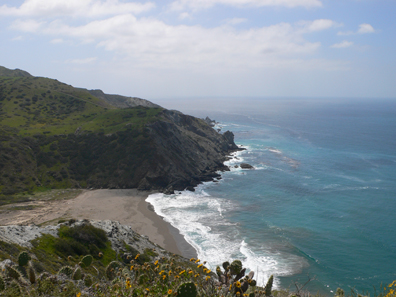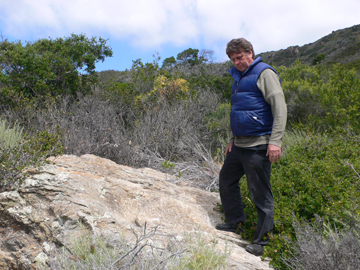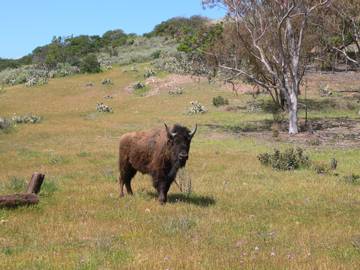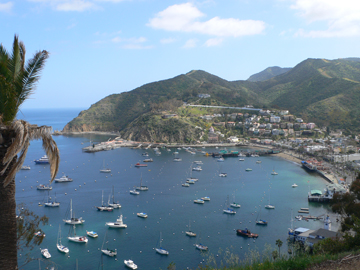|
Travels in Geology June 2008 posted June 19, 2008
Santa Catalina: The Channel Islandsí magical island
Jordan Clary
 Jordan Clary |
| Santa Catalina, an hour's boat ride off the coast of Southern California, boasts 80 kilometers of rugged, uninhabited coastline. |
Fred Freeman of the Catalina Island Conservancy speaks in the rambling drawl you might expect of someone who has spent most of his life on a relatively small rock surrounded by water and few people. For the past 46 years, he has called Santa Catalina Island home. As we drove around the island’s interior in one of the conservancy jeeps, I got the feeling that he knows each tree by name and when it was planted, every outcrop of rock and what it resembles, every endemic plant and every plant that is non-native.
On a recent visit to Santa Catalina Island, I took a Jeep Eco-Tour with Freeman and Bob Rhein, the conservancy’s director of media relations, to explore the delicate ecology of the island. Catalina is one of the Channel Islands, about 35 kilometers off the coast of Southern California, a place where valleys of wildflowers sweep down to the jagged coastline and silvery sand glitters along the shore. Although Catalina is not one of them, five of the Channel Islands are included as part of Channel Islands National Park, which was established in 1980 to preserve the biological diversity and the natural resources found on the islands and within surrounding ocean waters.
In May 2007, a wildfire burned 10 percent of Santa Catalina and the effects of that burn, combined with heavier than usual rainfalls, are still evident today. Wildflowers burst out everywhere: mariposa lilies — which Freeman said "look like [they've] got eyes inside of the blossom looking back at you” — fiddlenecks with small red flowers that look like the neck of a violin, bush sunflowers, larkspur, Indian paintbrush and black sage carpet the hillsides in a dazzling array of colors.
 Jordan Clary |
| Bob Clary examines a soapstone boulder that was carved out by the ancient inhabitants of Santa Catalina. |
Santa Catalina, which sits on the Pacific Plate, is basically a mountain that formed from upheaval as the Pacific Plate subducted beneath the North American Plate. According to a nature center at the island’s Airport in the Sky, the island then further uplifted and the rocks became metamorphosed as magma from the seafloor intruded upward. Today, marble and blue schist are among the metamorphic rocks that are most prominent. Serpentine, soapstone and quartz crystals can also be found among the rocky outcrops. Evidence of this volcanic intrusion can be seen in places like Echo Lake in the interior of the island, a small lake surrounded by hardened lava beds.
The island is also culturally significant. Archaeological excavations indicate that people have been living on Santa Catalina Island for at least 7,000 years. And the greater Channel Islands are home to the oldest dated human remains in North America — a female whose bones are dated to 13,000 years ago. Since Catalina’s rocky landscape doesn’t readily support agriculture, archaeologists speculate that the earliest islanders were primarily hunters and gatherers, collecting the bounty of the sea. But early on, some inhabitants developed a trading market as well. Hundreds if not thousands of years before the Spanish arrived, an active trade route existed with the one valuable commodity the island could produce: soapstone cooking pots. Because soapstone contains talc, cooking pots made of it don’t tend to crack when heated. Soapstone products from Santa Catalina have been discovered at archaeological sites as far east as New Mexico. The Jeep Eco-Tour includes a soapstone quarry where visitors can see hollowed-out stones once used for grinding seeds or nuts.
 Jordan Clary |
Santa Catalina's bison were first brought to the island in 1924 as part of a silent movie set. |
Though people had flourished on the island for thousands of years, it took less than a couple hundred years from when the Spanish first visited the island to knock out the entire population of natives. With Spanish colonization beginning in the early 1600s and the erection of missions along the coast in the mid 1700s, which meant more settlers, the Tongva population declined rapidly. By the mid-1820s, they had essentially disappeared from the island.
Today, Santa Catalina is home to a number of endemic plants and small animals, several of which are protected or under conservation programs. The Catalina Island fox, for example, was nearly wiped out after an outbreak of canine distemper virus in 1999, but an extensive recovery program that included captive breeding and vaccinations has brought the population up to about 572 at last count. Santa Catalina is probably most known for its bison. Fourteen bison were brought to the island in 1924 as extras in a silent movie. The bison never got their shot at stardom, but they were also not returned to the mainland and so roamed free in the island’s interior, which is largely uninhabited. The delicate ecosystem cannot support a large herd. A conservancy study concluded that a herd of 150 to 200 bison would be adequate to provide benefit for both the bison and the island’s ecology, so when the herd grows to more than 200, the excess bison are repatriated to a Lakota reservation in South Dakota.
 Jordan Clary |
Most of the 5,000 residents of Santa Catalina live in Avalon. |
Most of Santa Catalina is left to the bison, fox and other wildlife, and the day hikers, mountain bikers and eco-tourists. The majority of the island’s approximately 5,000 residents, and most of its visitors, congregate in the small city of Avalon, named for the mythical island in Camelot that Alfred Lord Tennyson wrote about in “Idylls of the King.” The island does have a magical feel to it and it’s easy to feel like you are in a completely different world once you arrive.
Once you do arrive in Avalon, via boat or helicopter, plan to head out to the 88 percent of the island that is still in its wild state. As well as the Jeep Eco-Tours, the Catalina Island Conservancy offers a number of opportunities for visitors to explore the stunning interior and stretches of virtually empty coast. One of the best ways is to sign up for a volunteer vacation. The camping spots for these volunteer vacations are in some of the island’s most pristine areas where you are guaranteed a spectacular night sky far away from any artificial lighting. For those who are not keen on sleeping outdoors, the conservancy has partnered with Catalina Island Vacation Rentals to combine a volunteer vacation with the comforts of a hotel. Santa Catalina is small enough that it’s easy to spend evenings in Avalon and still escape to the remote interior during the day. With 320 kilometers of trails and virtually empty roads, Santa Catalina is the perfect place for eco or geo travel. It’s easy to get to from Southern California on the Catalina Express leaving out of three Southern California ports — Dana Point, San Pedro and Long Beach — yet you feel a world away from California’s fast-paced cities.
Links:
Catalina Island Conservancy
Catalina Chamber of Commerce & Visitor’s Bureau
Catalina Express
Catalina Volunteer Vacations

 Subscribe
Subscribe


